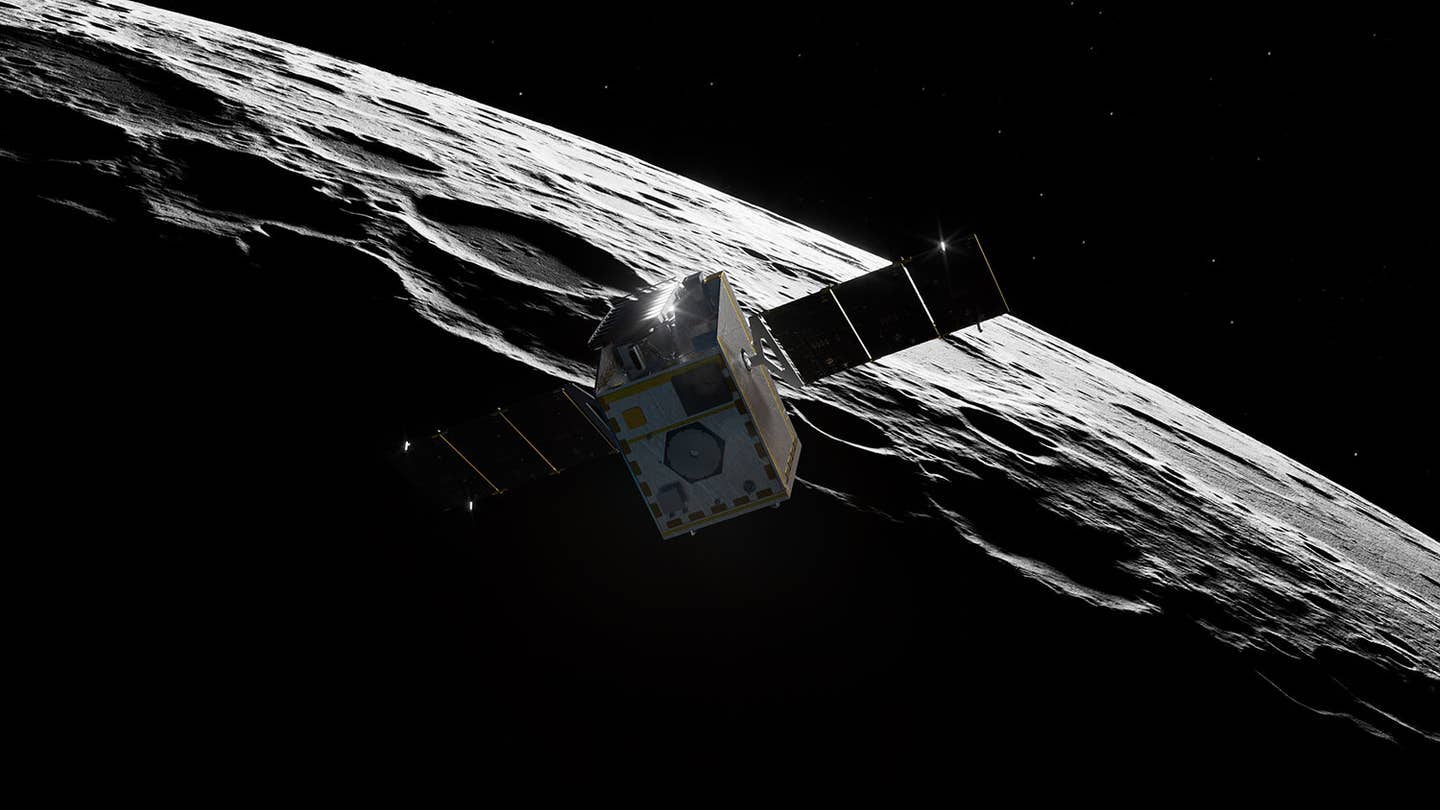NASA’s Lunar Trailblazer begins mission to find hidden water on the moon
A cutting-edge thermal imaging camera built by researchers at the University of Oxford is set to launch on February 26 aboard NASA’s Lunar Trailblazer mission. This ambitious effort aims to…

NASA’s Lunar Trailblazer approaches the Moon as it enters its science orbit in this artist’s concept. The small satellite will orbit about 60 miles (100 kilometers) above the lunar surface, producing the best-yet maps of water on the Moon. (CREDIT: Lockheed Martin Space)
A cutting-edge thermal imaging camera built by researchers at the University of Oxford is set to launch on February 26 aboard NASA’s Lunar Trailblazer mission. This ambitious effort aims to map water sources on the Moon, shedding light on its water cycle and paving the way for future robotic and human exploration.
The mission could provide crucial data on lunar water deposits, which may one day be processed for drinking water, breathable oxygen, and even rocket fuel.
Once in orbit, the 200-kilogram spacecraft, roughly the size of a washing machine, will analyze the lunar surface up to 12 times a day. Equipped with state-of-the-art instruments, it will capture data at an impressive resolution of 50 meters per pixel.
Special attention will be given to the Moon’s permanently shadowed craters, particularly at its South Pole, where scientists estimate up to 600 million metric tons of water ice could exist. If confirmed, these ice reserves could be a game changer for sustained lunar habitation.
A Mission Fueled by Collaboration and Innovation
The Lunar Thermal Mapper (LTM), a principal instrument on the spacecraft, was designed and built by the University of Oxford’s Department of Physics. Its role is to measure the Moon’s surface temperature and identify minerals that could indicate water presence.
Working in tandem with NASA’s High-resolution Volatiles and Minerals Moon Mapper (HVM3), the LTM will contribute to the most detailed lunar water maps ever created.
Professor Neil Bowles, Instrument Scientist for LTM at Oxford, emphasized the significance of the launch:
“The Lunar Thermal Mapper was designed, built, and tested here in Oxford, and the launch is an important moment for the whole team. The temperature measurements will help confirm the presence of the water signal in HVM3’s data. The two instruments will work together to map the Moon’s composition, revealing details we’ve only been able to speculate about until now.”
Related Stories
NASA selected the Lunar Trailblazer as part of its Small Innovative Missions for Planetary Exploration (SIMPLEx) program, which funds cost-effective science missions. The spacecraft will launch as a secondary payload, hitching a ride aboard a lunar lander developed by Intuitive Machines.
If everything goes as planned at NASA’s Kennedy Space Center in Florida, the first images from the LTM could reach Earth within three days of arrival in orbit.
Because the spacecraft has a relatively small engine, its journey to the Moon will rely on an efficient navigation method known as low-energy transfer. Instead of traveling in a direct path, it will use the gravitational forces of the Sun, Earth, and Moon to adjust its trajectory.
This approach will initially propel the spacecraft past the Moon and into deep space before the Moon’s gravity pulls it back. A series of small thruster bursts will then fine-tune its orbit until it stabilizes at approximately 100 kilometers (60 miles) above the surface. The entire journey is expected to take between four and seven months.
Decoding Lunar Water’s Origins and Distribution
Scientists still debate how water arrived on the Moon and why it persists in some areas. Theories range from comet and asteroid impacts delivering ice to ancient volcanic eruptions releasing water vapor from the Moon’s interior.
Another possibility is that hydrogen from solar wind interacts with lunar surface oxygen to form water molecules. The data collected by Lunar Trailblazer will help determine which of these scenarios is most likely.
The mission will provide answers by observing how water behaves under different lunar conditions. By continuously mapping the surface, researchers hope to understand whether water molecules shift between solid and gas states based on temperature variations.
For example, when sunlight heats the surface, water may evaporate and later condense in colder, permanently shadowed regions.
Lauren Taylor, Major Projects Lead at the UK Space Agency, expressed excitement about the mission’s potential:
“The UK Space Agency is thrilled to be part of NASA’s Lunar Trailblazer mission. Our work with the University of Oxford to develop the Lunar Thermal Mapper highlights the UK’s leadership in space exploration and scientific research. This mission will provide invaluable data on the Moon’s water resources, supporting future human missions and expanding our understanding of the lunar environment.”
The Technology Behind Lunar Water Detection
Lunar Trailblazer relies on two sophisticated instruments—LTM and HVM3—to detect and map lunar water. The Oxford-designed LTM will measure surface temperatures from approximately -163°C to 127°C using four broadband infrared channels.
Additionally, its eleven narrow infrared channels will analyze the mineral composition of lunar rocks and soils. Identifying these materials will help pinpoint where water may be hidden beneath the surface.
HVM3, developed by NASA’s Jet Propulsion Laboratory, will complement LTM by detecting and mapping water in different forms—such as ice, frost, or bound within minerals. It does this by measuring spectral fingerprints, which are unique wavelengths of reflected sunlight that indicate the presence of specific substances.
However, temperature significantly influences the strength of these absorption signals. That’s where LTM plays a crucial role—its temperature readings will calibrate HVM3’s spectral data, ensuring more accurate water mapping.
By collecting data during both lunar day and night, Lunar Trailblazer will determine whether water molecules remain stationary or migrate across the surface. This could help answer key questions, such as whether water molecules are trapped within lunar rocks or if they accumulate in cold, shadowed craters.
Lunar Trailblazer Mission Researchers
The Lunar Trailblazer mission is led by Professor Bethany Ehlmann at the California Institute of Technology (Caltech) and managed by NASA’s Jet Propulsion Laboratory.
The LTM’s optical components were manufactured at Durham University’s Centre for Advanced Instrumentation, with infrared filters supplied by Cardiff University and specialist manufacturers across the UK. RAL Space provided early electronics and software support.
With its collaborative international effort and cutting-edge technology, Lunar Trailblazer represents a significant step toward sustainable human exploration of the Moon. The findings from this mission will not only shape future lunar expeditions but may also offer insights into how water behaves on other airless planetary bodies.
As scientists eagerly await the first wave of data, the dream of harnessing lunar resources for long-term space exploration inches closer to reality.
Note: Materials provided above by The Brighter Side of News. Content may be edited for style and length.
Like these kind of feel good stories? Get The Brighter Side of News' newsletter.
Joseph Shavit
Head Science News Writer | Communicating Innovation & Discovery
Based in Los Angeles, Joseph Shavit is an accomplished science journalist, head science news writer and co-founder at The Brighter Side of News, where he translates cutting-edge discoveries into compelling stories for a broad audience. With a strong background spanning science, business, product management, media leadership, and entrepreneurship, Joseph brings a unique perspective to science communication. His expertise allows him to uncover the intersection of technological advancements and market potential, shedding light on how groundbreaking research evolves into transformative products and industries.



